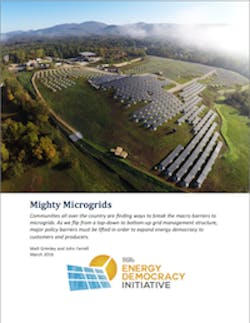The electric grid pulses with the power from thousands of large power plants, pushing electrons in every direction. It’s considered one of the greatest engineering achievements of the 20th century. Every year in the United States, homeowners and businesses spend more than $360 billion on electricity.1 That’s more than two percent of the national gross domestic product, flowing out of towns and cities to reimburse owners of huge power plants, far-stretching power lines, and a century-old style of energy production.
The very scale of the electricity system introduces inefficiencies. Most power plants waste two- thirds of their fuel’s energy as heat. Transmission and distribution power lines lose another two to 13 percent of the energy. Meanwhile, monthly outages have increased six-fold over the past decade. According to a Lawrence Berkeley National Laboratory study, “increased [transmission and distribution spending on the grid] in the previous year was not correlated… with improvements in reliability in the following year.” According to the same study, extreme weather conditions – most likely exacerbated by climate change and carbon pollution – are correlated with an increase in outages.
The electric grid is no longer a 20th century, one-way system. Customers can increasingly make choices to have greater control over reliability, resiliency, and more energy efficiency. Encouraged by rapidly decreasing costs, people have put solar on their homes, sending energy back to the grid. Smart devices such as batteries and thermostats can work with the utility to absorb or lower energy use. Electric car batteries can store plentiful solar and wind energy. With larger buildings or campuses, combined heat and power systems transform inefficient power only systems into highly efficient heating and power resources.
This constellation of distributed energy technologies is now enabling the microgrid, one of many new local solutions to generating energy. Ironically enough, the industry is going back to the future, back to the Name of the fledgling electric utility companies that emerged after Thomas Edison opened his small Pearl Street, New York City power station in 1882. Edison envisioned that the electric utility industry would involve small firms generating power for individual businesses through such networks. By 1886, Edison’s firm had installed 58 micro-grids.6 But soon, the emergence of alternating current enabled long distance transmission of electricity, which helped shift the focus to the larger utility monopolies that dominated power markets for the next century.
